danbricklin.com/log
|
||
|
|
Starting November 1, 1999
Busy today with a long meeting, People notice, Learning from the real world, ICANN funding, Halloween, Seasons, Trademarks and domain names
1-2Nov99
1999-11-1.htm
|
|
Tuesday, November 2, 1999
Busy today with a long meeting
We had a meeting of the board of directors today at Trellix. Here's a photo (people are starting to run when I show up with a camera...):
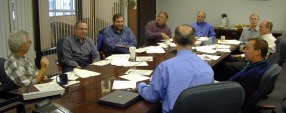 Trellix Corporation board meeting
Like many startups, the board consists of venture capital investors (who are actually quite helpful, as they should be) and industry heavyweights.
Visible in the picture are (starting on the left) Frank Moss (Trellix director, former CEO of Tivoli, now helping others including Bow Street), Eric Sall (Trellix VP), David Litwack (Trellix director, former president of Powersoft, now CEO of Silverstream), Steve O'Neill (Trellix EVP), Russ Werner (Trellix director), Tim Barrows (Trellix director, General Partner of Matrix Partners -- a VC), Peter Traynor (Trellix CFO), Ted Dintersmith (Trellix director, principal at Charles River Ventures -- another VC), and Don Bulens (Trellix director and CEO). Not shown: me (Trellix director, founder and CTO, photographer) and a representative of HarbourVest Partners, Alex Rogers (another investor), by phone.
People Notice
This log has been mentioned in Scripting News, Dave Winer's weblog, as well as in Robot Wisdom and Kottke.org. Thank you! I hope I can live up to what Jason Kottke wants and "...publish new insights on old thoughts and compare others' new ideas with old paradigms." See if the item below comes close (I planned it before reading Jason's request).
Also, Dan Gillmor of the San Jose Mercury News, who recently started his own eJournal, had kind words about this site in posting 11 of his weblog forum.
Learning from the Real World
The speaker that seemed to be the most controversial at Agenda 2000 was not George W. Bush or Al Gore, nor even Rupert Murdoch CEO of News Corporation. Rather it was Ray Kurzweil, of Reading Machine for the Blind and musical instrument fame. Ray is a neighbor (I've walked my dog by his house late every night for years) and a very sweet and contemplative person. (You can read about him on the Kurzweil Technologies web site.)
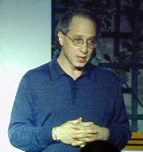 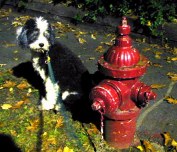 Ray Kurzweil speaking at Agenda 2000; walking the dog last night near Ray's house (note the pretty leaves!)
Ray gave the dinner speech the last night, basically discussing some of the ideas in his new book, The Age of Spiritual Machines, especially Chapter 6, "Building New Brains..." The book has been widely reviewed, and Ray has been making the talk show circuit. The main thesis that he presented to us that night is that human beings are moving past DNA-based evolution to computational- and electronic-based evolution. He talked about using nanobots injected into our bodies to scan the structure and neurotransmitter makeup of our brains, and then downloading that information into special computer hardware, and doing it by the 2030's or so when many of us will still be alive.
He then quoted (more or less) his book on page 125 where he wrote (emphasis added):
Interacting with the newly instantiated person will feel like interacting with the original person. The new person will claim to be that same old person and will have a memory of having been that person...having walked into a scanner here, and woken up in the machine there. He'll say, "Hey, this technology really works."
...As we port ourselves, we will vastly extend ourselves. Remember that $1,000 of computing in 2060 will have the computational capacity of a trillion human brains...
His conclusions were quite disturbing to many people at the conference, and there was lots of talk afterwards trying to poke holes in his theories, though none of us had read the book yet. (Luckily a copy was included in our conference "goodie bag". I already had an unread copy at home thanks to Ray and to VisiCalc being mentioned in his timeline.)
Recently, thinking about Ray's solution to making Artificial Intelligence "work", I was struck by the similarity to his previous problem solving techniques.
When Stevie Wonder (a blind user of his reading machine) asked him to build a musical instrument with the rich complex sounds of acoustic instruments, like a piano or violin, and the extraordinary flexibility of computer-control, his solution was to build a synthesizer based on sampled sounds, the famous Kurzweil 250. Now his solution to artificial intelligence is sampled brains. (Ray liked the juxtaposition when I mentioned it to him.)
It is interesting that we have moved from draw programs like Adobe Illustrator to paint programs like Adobe Photoshop for many of our illustrations. Sampling the real world seems to be the way to go.
Sampling what came before has always been "in". Even the Bible, a quite old book, describes creation as follows: "God said: Let us make humankind, in our image, according to our likeness!" (From The Schocken Bible, Everett Fox's translation that tries to "echo the style of the original...mimic the particular rhetoric of the Hebrew wherever possible.")
Monday, November 1, 1999
ICANN Funding
According to CNET, the Markle Foundation is going to help fund a general election for part of ICANN's board. The president of the Foundation is Zoe Baird, and the interim chair of ICANN is Esther Dyson. That reminded me of this picture from Esther's last PC Forum that I took. It shows how Zoe was taking input from a wide variety of sources:
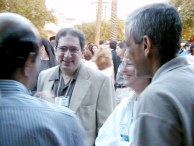 Discussion at PC Forum, March 1999
Left to right as far as I can tell: Joel Klein (DOJ), Mitchell Kertzman (Network Computer, now named Liberate), Zoe Baird (Markle Foundation), and Vinod Khosla (Kleiner Perkins).
Halloween
Yesterday was Halloween. Time for last minute candy buying. Here's the way I looked 22 years ago at a Halloween party at Bob Frankston's house:
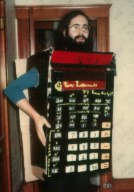 Halloween 1977
I made a costume to look like a Texas Instruments Business Analyst calculator, modeled on the one that later inspired me to do VisiCalc and that helped set the royalty percentages. (See the History page about the Idea for VisiCalc to learn more about that calculator.) I put a flashlight behind the display so the numbers lit up. The buttons, though, were cardboard and didn't depress.
Seasons
I like New England. I like weather and the seasons. I know people from other parts of the country, especially California, complain about weather that changes and has extremes, but I love the range we get here in the Boston area.
It's autumn now. I went bike riding yesterday along the Charles River from Watertown to Cambridge. It was heavenly.
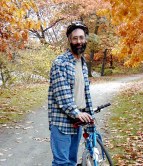 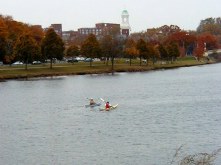 Autumn in New England along the Charles River
The constantly changing weather and seasons reminds you of the rhythms of real life.
Trademarks and Domain Names
I've been following some of the discussion about trademarks and domain names. To kill off "squatters", trademarks holders want to pull domain names away from people (often without much warning) and suddenly URLs will point to new places you don't expect. There is much emotion here. Stories of children with their domains named for their hobbies snatched by unfeeling lawyers. Pirates extorting large sums from technologically delayed companies. Etc.
Bob Frankston, my old partner from the VisiCalc days as well as close friend and neighbor, has been working on an essay about "Safe Haven" names that give the benefit of today's domain names (i.e., not being tied to any specific IP address so you can change servers, and permanent so links won't break over time no matter what happens to legal names) without being tied to politically hot things like trademarks. Bob says:
"Making handle assignment political threatens the basic 'glue' of the Internet."
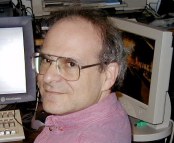 Bob in his office yesterday
This got me thinking about trademarks and domain names, so I wrote this:
Trademarks (marks of tradesmen) were used for many, many years to identify the source of items and to distinguish one tradesperson's crafts from another (like Revere's name or symbol on a pewter piece). The idea of trademarks was to avoid confusion on the part of the purchaser, and much of trademark law as I understand it rests on determining confusion between marks. Today the definition of a trademark says that it "...identifies and distinguishes the source of the goods and services of one party from those of others" (Basic Facts About Trademarks, US Patent and Trademark Office). The marks were originally symbols like boars, hog's heads, red labels, black labels, lions, etc., and eventually words and names.
To avoid confusion, trademarks had to be unique and not confusing within their sphere, like the naming of drugs. Therefore, Cadillac cars were only made by General Motors, but there was no confusion with Cadillac dog food. Madonna the singer, Madonna the hospital, Madonna the religious icon -- no confusion. Smith the college, the person, the company. Bricklin the car, Bricklin the software, Bricklin the person. Each namespace (cars, dog food, singers, hospitals, people, etc.) had its own way to keep the names unique within its space. When you file for a trademark you must specify a Class of goods or services. (E.g., Class 7 is Machinery, Class 8 is Hand Tools.) You can't register a mark on "everything that ever exists".
The problem with moving trademarks without thinking to the Internet is easy to see: convergence. We converge all namespaces that logically separate in the traditional world into one namespace in the domain name world. People used to policing their little space (cars, dog food, hand tools, whatever) now are all mixed up into one space. Entities not used to fighting for space (people, non-profits, informal organizations) are mixed in, too. Saying we'll just use normal trademark practices to solve the problems won't work. The checks and balances we had to keep each of the namespaces filled with unique names doesn't work when you throw in many existing namespaces with overlapping names and no established universal way of ensuring uniqueness or reassigning names. You can only ensure uniqueness when you start from scratch and keep it unique. We must leave separate namespaces with their own ways of avoiding name confusion. (Bob Frankston addresses these last two items through a new unique "handle" namespace and directories.) Adding to the problem is that the Trademark law concept of being "confusingly similar" is too subjective to use in the fast paced world of the Internet.
You can link to a copy of the previous item at www.bricklin.com/tmdns.htm.
|
||
|
© Copyright 1999-2018 by Daniel Bricklin
All Rights Reserved.
|
||